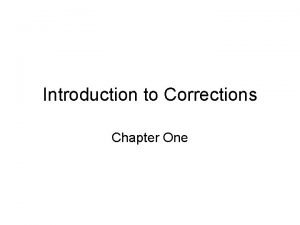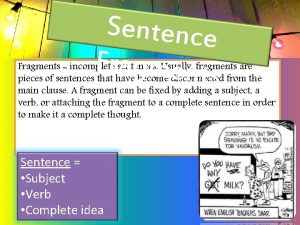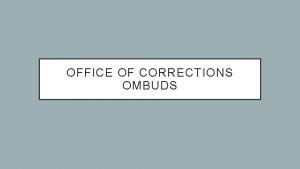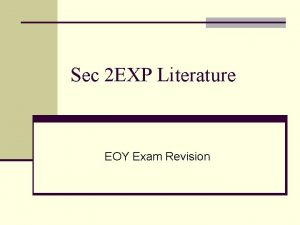Corrections for Sec 3 Express E History EOY



![Question 1(a) n Cartoon [Question Paper] n Cartoon’s message has to be inferred in Question 1(a) n Cartoon [Question Paper] n Cartoon’s message has to be inferred in](https://slidetodoc.com/presentation_image/72a29d98cceac90ef84ef8ccd68bd6d5/image-4.jpg)









- Slides: 13

Corrections for Sec 3 Express E. History EOY Exam 2009

Results Analysis 3 A (8 students) 3 B (13 students) 3 C (9 students) 3 D (9 students) No. Passed 6 (75%) 13 (100%) 7 (78%) 3 (23%) No. Failed 2 (25%) 0 (0%) 2 (22%) 6 (67%) Distinctions 2 (25%) 2 (15%) 0 (0%) Class MSG 4. 38 4. 15 4. 44 7. 56

Top Students (Top 5 Positions) 1. Yong Jin Yu 2. 3. 4. 5. marks Wendy Lee / Dillon Chia Lee Boon Bing Neo Shi Yun / Jeslyn Oh Soen Min Wen / Dion Gan marks 74 72 marks 70 marks 68 marks 66
![Question 1a n Cartoon Question Paper n Cartoons message has to be inferred in Question 1(a) n Cartoon [Question Paper] n Cartoon’s message has to be inferred in](https://slidetodoc.com/presentation_image/72a29d98cceac90ef84ef8ccd68bd6d5/image-4.jpg)
Question 1(a) n Cartoon [Question Paper] n Cartoon’s message has to be inferred in the context of 1928 (what is the significance? ) and later on, what happens? n The CAPITALIST refers to the WEST (Capitalism)

Question 1(a) n The message of the cartoon is to silence critics who did not believe in the Five Year Plans and sought to discredit it. It is also designed to prove to Western capitalist nations that Communism, under Stalin’s leadership is working. n This can be supported by the evil capitalist calling the Five Year Plans “Fantasy, Nonsense, Utopia!” but being silenced and crushed when the Five Year Plans succeeded Five Years later with rapid “industrialization and the collectivization of farms. ”

Question 1(b) n Similarity and Difference in CONTENT: n Sources B and C are both similar in highlighting that errors were made by the Russian government with regards to the Five Year Plans which resulted in negative effects of collectivization. This is supported by Source B where “many grievious difficulties and mistakes which were made” and in Source C where “a political decision made by the Central government” resulted in famine and suffering by the Russians.

Question 1(b) n Similarity and Difference in CONTENT: n Sources B and C are both different as they show different effects of collectivization. Source B shows the positive effects of collectivization while Source C shows the negative effects. Source B shows how the workers have benefited from achievements like “public works”, “increased health services”, “extended education”, etc.

Question 1(b) n Similarity and Difference in PURPOSE: n Sources B and C differ in purpose. The purpose of Source B is to prove that collectivization and the 5 -year-plans and thus the Communist political system was a success. By having British visitors praise the system and even consider the idea that they should adopt it for Britain would be a political victory for Stalin as it would be published in a British newspaper and it would mean that the capitalist governments would have to accept that the communist economic system was a success.

Question 1(b) n Similarity and Difference in PURPOSE: n On the other hand, the purpose of Source C is to criticize collectivization and the 5 -yearplans and to show that it is a failure. By showing how there was a famine and how Russian children suffered and died from starvation, the source clearly discredits the policy of collectivization. The purpose of the source would be to dissuade others from believing the propaganda fed by Stalin to show successful collectivization was.

Question 1(c) n Yes. Source D proves that the policy of collectivization was a failure because people were starving and dying from a lack of food. He even described how a peasant was so hungry that he ate a crust of bread an orange peel from a spittoon. This can be supported by crossreferencing to Source C where a Communist Party member in the Ukraine witnessed that people there were dying of starvation as a result of the failure of collectivization as “they had been trapped and left to starve by a political decision made by the Central government. ”

Question 1(c) n No. Source D does not prove that the policy of collectivization was a failure because the source is from a British government official. He may have made this report to discredit the communists to show that communism / collectivization is a failure so that the British public would not support communism. This can be supported by cross-referencing to Source B where other British visitors to the USSR saw “hopeful, enthusiastic and self-respecting workers” and “achievements like developing public works, etc”. The British visitors even felt that collectivization would “greatly benefit Britain if they could encourage British workers to adopt the systems.

Question 1(d) n Yes. Source E is useful in telling me about the success of Stalin’s collectivization because grain production increased. The graph shows that from the start of the Collectivisation in 1928 to the third Five Year Plan, grain production had increased from 73 million tonnes to 95 million tonnes.

Question 1(d) n No. Source E is not useful in telling me about the success of Stalin’s collectivization because the statistics could be bias as Stalin’s government regularly fed people false information. During the Five Year Plans, many of the ‘official’ statistics published were made up to make the economic situation seem better than it was. n In Source C, a Communist Party member in the Ukraine witnessed that people there were dying of starvation as a result of the failure of collectivization as “they had been trapped and left to starve by a political decision made by the Central government. ” OR n In Source D, a former British government official who visited Russia in 1933, during the Collectivisation period saw that many people were hungry and dying of starvation. He even described how a peasant was so hungry that he ate a crust of bread an orange peel from a spittoon.
 Subject combination sec 3 na
Subject combination sec 3 na Subject combination sec 3
Subject combination sec 3 Collectivization
Collectivization Larch corrections center
Larch corrections center Klamath county community corrections
Klamath county community corrections Correction in cjs
Correction in cjs Comma splice examples and corrections
Comma splice examples and corrections Florida department of corrections mission statement
Florida department of corrections mission statement Department of corrections wisconsin
Department of corrections wisconsin Intro to corrections
Intro to corrections Which of the following is a sentence fragment marina
Which of the following is a sentence fragment marina Orange county community corrections
Orange county community corrections Office of corrections ombuds
Office of corrections ombuds Tangential scale distortion
Tangential scale distortion























